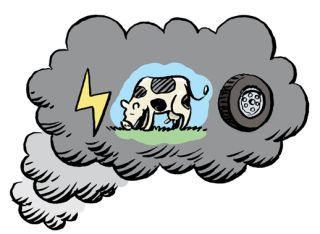Wind and solar power key to electricity sector targets

In 2023, emissions from the electricity sector fell by just over a fifth from 2022 to the lowest level since records began in 1990. This was driven by a considerable decline in the use of coal for electricity generation, coupled with a notable rise in imported electricity. Despite this progress, Ireland’s electricity sector needs to reduce emissions by 75 per cent by 2030 to stay within the agreed carbon budget. This is the largest reduction in sectoral emissions of all sectors.
The Climate Change Advisory Council ‘Annual Review 2024: Electricity’ provides an overview of progress to date in the Electricity sector in terms of reaching agreed carbon budgets and makes recommendations to increase emissions reductions in the electricity sector. According to the report, to stay within the agreed carbon budget, the Electricity sector needs to achieve the largest reduction in sectoral emissions of all sectors: a 75% decrease by 2030 compared with 2018. Generation from renewable sources has increased slightly, primarily driven by solar power, but it remains significantly below the annual increase needed to meet growing demand and simultaneously satisfy 2030 targets for emission reductions. Delays and appeals in the planning process for onshore wind projects in particular are significantly hindering progress.
The Electricity sector is the third largest sector by emissions in Ireland. It accounts for emissions from a total of 15 fossil fuel-fired generating stations, one peat briquetting plant, one waste-to-energy facility, one natural gas production platform and one natural gas refinery. Preliminary data for 2023 indicate that emissions from the Electricity sector in 2023 were 7.6 Mt CO2. This represents a significant (21%) reduction in Electricity sector emissions year on year and the lowest annual emissions for the sector since current official inventories began in 1990.
EU Emissions Trading System data also indicate a reduction in emissions from electricity generation of almost 24% in 2023. This is largely due to a 50% reduction in the use of coal for electricity generation relative to 2022, paired with a 12-fold increase in net electricity imports from the UK driven by, among other things, a lower UK carbon price. Imported electricity, regardless of the generation fuel mix, is not included in the energy industry emissions in the Irish greenhouse gas emissions inventory. Emissions associated with electricity imported from the UK are included in the UK inventory.
The year 2024 is critical for the Electricity sector. To achieve the 2025 and 2030 targets and remain within the sectoral emissions ceiling, the following is required:
- The use of coal for electricity generation must cease at the earliest opportunity.
- Significant imports of electricity from the UK need to be maintained.
- The renewable share of electricity generation must significantly increase.
- The growth in demand for electricity will need to be limited.
Sectoral emissions ceiling and key Climate Action Plan targets
The Electricity sector has been set the steepest decline in emissions of all sectors: its emission ceilings are 40 Mt CO2 eq for the first carbon budget period 2021–2025) and 20 Mt CO2 eq for the second carbon budget period 2026–2030. A 75% reduction in emissions in the sector by 2030, compared with 2018 levels, is to be achieved by increasing the share of renewable electricity to 80%, encompassing 9 GW of onshore wind capacity, at least 5 GW of offshore wind capacity and 8 GW of solar photovoltaic (PV) capacity and supported by a range of actions set out in the Climate Action Plan.
Approximately 49% of the sectoral emissions ceiling has now been used in the first 2 years of the first carbon budget period 2021–2025. Progress towards targets for onshore wind in 2023 was limited, with just 0.2 GW of new onshore wind connected to the grid, bringing the total connected onshore wind capacity to 4.7 GW. Solar power became the country’s fastest-growing renewable source in 2023, with record connections of small-scale rooftop solar installations by households and businesses as well as larger, grid-scale, solar installations. By the end of 2023 a total of 0.7 GW of solar power, comprising 0.4 GW grid-scale and 0.3 GW small-scale rooftop solar installations, was connected to the grid. However, despite the rapid growth in solar connections in 2023, Ireland is not on track to achieve the target of up to 5 GW solar power generation by 2025.
Key recommendations
- Government urgently needs to complete the planning reform required to accelerate the installation of sufficient wind and solar power to achieve the annual average increase of 1.6 gigawatts of onshore renewable electricity that is needed to meet national targets.
- It is critical that the use of coal to generate electricity is stopped by 2025 and that the use of oil is phased out as soon as possible.
- Government should ensure pricing incentives for data centres and other large energy users to shift electricity usage to times of low carbon emissions and to give the public access to data on their energy efficiency and sustainability performance.
- Government urgently needs to adopt the plan for the roll-out of offshore wind power off the south coast to avoid further delays in offshore wind generation.
- Government should publish a long-term strategy with timelines for the delivery of a reliable and zero-carbon electricity system well in advance of 2050 and ensure that publicly owned energy companies take full account of the Climate Act in setting their own objectives.
- Planning processes must ensure that new energy infrastructure is developed to withstand future projected climate impacts. Operators must act now to reduce known flood risks to critical infrastructure and take account of protecting and, where possible, enhancing biodiversity in new infrastructure developments. Government and operators need to enhance resilience to power outages and work closely with all communities to identify and develop the technologies required.